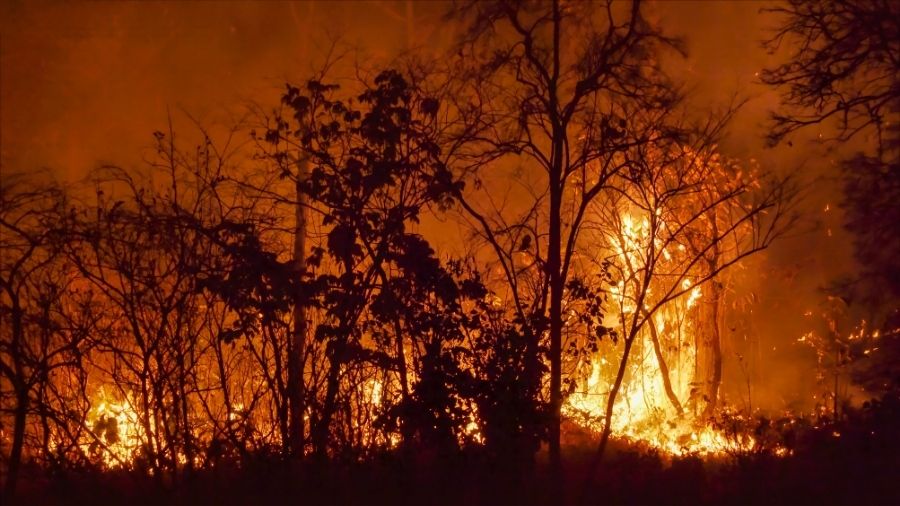Natural disasters can be extremely dangerous, and over the years, there have been many that have affected Earth. These unpredictable events have taken millions of lives throughout history and caused mass destruction. Natural disasters include tsunamis, earthquakes, volcanic eruptions and floods. This blog explores 30 of the most deadliest that have shaped history.
1. The 1931 China Floods

This flood affected many areas, including the Yangtze, Yellow, and Huai River basins. In 1931, there was extreme rainfall, which combined with snow that had melted, causing the rivers to overflow. The areas around the rivers were hugely impacted, and flood waters covered farmland and cities. This natural disaster highlights the dangers of living close to large rivers which can overflow. Around 1 million to 4 million people lost their lives to this devastating flood, it is believed.
2. The 2004 Indian Ocean Tsunami
This is one of the most powerful earthquakes that has ever been recorded. This earthquake had a magnitude of 9.1-9.3 and caused waves to sweep inland. The waves reached up to 30 meters (98 feet) in some areas, which made this a deadly Tsunami. Fourteen countries around the Indian Ocean were affected by this tsunami, where over 230,000 people were killed.
3. The 1556 Shaanxi Earthquake

This deadly natural disaster happened in the Shanxi region of China. This earthquake caused great destruction to the area and claimed around 830,000 lives. Due to the tremors, the whole city collapsed, and many buildings were destroyed due to the materials they were made from. This was one of the worst earthquakes ever recorded.
4. The 1815 Eruption of Mount Tambora

The eruption of Mount Tambora in Indonesia pushed large amounts of debris and ash into the atmosphere. It happened in 1815 and destroyed many crops. At the time, it was known as the "Year without a Summer" due to the devastation it caused. Due to the crops being destroyed, a famine occurred, and many diseases were also widespread. Around 71,000 people died during this natural disaster. This natural disaster also impacted food supplies in North America and Europe as the eruption caused temperatures to drop.
5. The 1976 Tangshan Earthquake
The Tangshan Earthquake struck the city of Tangshan in northeastern China on July 28, 1976. Around 242,000 people lost their lives, although some have estimated around 700,000 actually died due to this natural disaster. This earthquake had a magnitude of 7.5 and destroyed the city's infrastructure. This has been classed as one of the deadliest in the 20th century.
6. The 2008 Sichuan Earthquake
This earthquake had a magnitude of 7.9 and hit the Sichuan province in southwestern China. On May 12, 2008, this earthquake took the lives of 87,000 people and injured over a million more. Villages were buried due to landslides, and other infrastructure like bridges were always destroyed in this natural disaster.
7. The 1991 Bangladesh Cyclone

This cyclone affected Bangladesh's southeastern coastal region. This natural disaster is one of the worst cyclones that have been recorded. It happened on April 29 1991. The wind speed was recorded at over 150 mph (240 km/h). This storm killed around 138,000 people and displaced millions more in the area.
8. The 2010 Haiti Earthquake
This earthquake happened on January 12, 2010, and is one of the most deadly ones that have been recorded. It had a magnitude of 7.0 and struck the capital of Haiti, Port-au-Prince. It is believed around 160,000 people lost their lives, and over 1.5 million people were displaced due to the devastation that this earthquake caused. Many people were trapped under the rubble once the earthquake hit, and the country found it hard to recover due to the poverty it was already experiencing.
9. The 1960 Valdivia Earthquake
This is known as the Great Chilean Earthquake and occurred in 1960. It had a magnitude of 9.5, which is one of the highest-ever recorded earthquakes in history. There were an estimated 1,000 to 6,000 people that lost their lives. This natural disaster caused issues for other countries such as Hawaii, Japan, and the Philippines, where it affected their coastline.
10. The 1994 Rwandan Genocide
While not a natural disaster in the traditional sense, the 1994 Rwandan Genocide was exacerbated by natural factors. Severe droughts and flooding during this period worsened food insecurity, making the population even more vulnerable. Around 800,000 people died in 100 days due to this genocide. This marks a very dark time in history.
11. The 1959 Palm Sunday Tornado Outbreak

The 1959 Palm Sunday Tornado Outbreak occurred across the central United States. There were 255 people killed due to this tornado, and it was recorded as a powerful F5 tornado. It happened on April 11, 1959 and is one of the worst tonados recorded in history. It affected many areas, including Kansas, Iowa, and Nebraska. There was a combination of multiple tornadoes, making this one of the deadliest tornadoes at the time.
12. The 2015 Nepal Earthquake
Nepal was hit by a magnitude of 7.8 earthquake. There were over 21,000 people injured, and millions of people lost their homes. This natural disaster really impacted the area and caused a lot of damage. It occurred on April 25 2015. Many buildings were destroyed, including historical buildings. There were nearly 9,000 deaths that were recorded.
13. The 2003 European Heatwave

This natural disaster claimed the lives of around 70,000 people. The temperatures showed how climate change is affecting various places in the world. It happened in 2003 when the weather was extreme and produced a lot of heat in Europe. The area isn't used to extreme heat, so for many people, it was a real struggle. There were forest fires and crop losses, which impacted many people.
14. The 1970 Bhola Cyclone
The 1970 Bhola Cyclone remains the deadliest tropical cyclone ever recorded. It struck East Pakistan (now Bangladesh) and the West Bengal region of India on November 12, 1970. The storm killed between 300,000 and 500,000 people, mainly due to the storm surge that inundated low-lying areas.
15. The 1999 İzmit Earthquake
This earthquake impacted the city of Izmit in the northwestern region of Turkey. This area houses a large population and has killed more than 17,000 people. This disaster highlighted how this area could be very vulnerable to earthquakes in the future. This particular earthquake has a magnitude of 7.6 and occurred on August 17, 1991. This area needs to be prepared for future disasters, as this volcano has the potential to do the same thing again.
Throughout history, these disasters have shown both the strength and fragility of our planet. Yet from the same forces that destroy, new life always emerges. Nature’s elements—earth, air, fire, and water—don’t just shape the land; they also inspire creativity. Many of our handcrafted instruments made from wood, bamboo, and seeds are born from those same natural materials, reminding us of the balance between destruction and creation.
16. The 1887 Yellow River Flood

The 1887 Yellow River Flood in China was one of the deadliest floods in human history. It is estimated that around 900,000 to 2 million people died in this terrible natural disaster. The flood caused a famine as it destroyed many crops, which further contributed to the death toll. This has made it one of the deadliest natural disasters in history.
17. The 1947 Texas City Disaster
On April 16, 1947, a series of explosions at a fertilizer plant in Texas City, Texas, resulted in the deaths of at least 581 people, with thousands more injured. The blast, caused by the accidental detonation of ammonium nitrate, levelled large parts of the city. While this was technically an industrial disaster, the destruction caused by the explosion was on a scale similar to a natural disaster.
18. The 1908 Messina Earthquake

The Messina Earthquake of 1908 struck southern Italy and the island of Sicily. This earthquake caused Tsunamis to occur, which caused damage to coastal areas. It had a magnitude of 7.1 and killed at least 100,000 people.
19. The 1974 Bangladesh Flood
Over the years, Bangladesh has experienced multiple deadly floods. Really heavy monsoon rains and the overflow of the country's rivers caused flooding across the region. Resulting in more than 26,000 people lost their lives in the flooding, which also caused extensive damage to crops, homes, and infrastructure.
20. The 1906 San Francisco Earthquake
This earthquake killed over 3,000 people and happened on April 19, 1906.
This earthquake was the cause of many buildings being destroyed, which has had a lasting impact on communities. The damage it caused to the city was huge. This incident highlighted how emergency services need to respond in the future if it is to happen again. There was more devastation created by this earthquake, as there were fires breaking out, which lasted for many days.
21. The 1812 Caracas Earthquake
This earthquake caused a huge amount of devastation and had a magnitude of 7.7. It occurred in 1812 and happened in the Venezuelan city of Caracas. There were around 20,000 people who died, and many buildings collapsed, causing a lasting impact on the city. It is classed as one of the most dangerous earthquakes that have happened in South America.
22. The 2011 Tōhoku Earthquake and Tsunami

Japan was hit by a deadly earthquake, which had a magnitude of 9.0. It happened on March 11, 2011. This was then followed by a powerful tsunami. The tsunami waves reached heights of up to 40 meters (131 feet) and caused massive destruction, particularly in the coastal areas of Tōhoku. More than 15,000 people lost their lives, and the disaster also caused the Fukushima Daiichi nuclear disaster.
23. The 1977 Khyber Pass Earthquake
This earthquake had a huge impact on the infrastructure in the area and caused extensive damage. The 1977 Khyber Pass Earthquake struck the border region between Afghanistan and Pakistan. This happened on May 29, 1977. The 7.6 magnitude earthquake killed over 5,000 people and injured many others. Due to the location of the disaster area, it made rescue and recovery efforts incredibly difficult to carry out.
24. The 2005 Kashmir Earthquake
This earthquake is one of the most deadly natural disasters that have occurred in Pakistan. It will be remembered in history for the impact it caused. It caused the deaths of over 80,000 people, with millions more injured and displaced. It had a magnitude of 7.6 and occurred on October 8, 2005. It hit the Kashmir region in Pakistan.
25. The 1918 Spanish Flu Pandemic

While not a traditional natural disaster, the Spanish Flu of 1918 was a deadly global pandemic. It claimed the lives of around 50 million people worldwide. The flu spread rapidly and caused widespread mortality, making it one of recorded history's most lethal health disasters.
26. The 1900 Galveston Hurricane
The 1900 Galveston Hurricane is the deadliest natural disaster in U.S. history. It struck the Texas coast on September 8, 1900. It had winds that reached 145 mph (233 km/h). The storm killed approximately 6,000 people and destroyed many homes. The whole city of Galvest was devastated by the storm surge and flooding.
27. The 2003 Bam Earthquake
The 2003 Bam Earthquake struck southeastern Iran on December 26, 2003. With a magnitude of 6.6, the city of Bam was almost destroyed. This was due to the time of the year, as the winter months had exacerbated the impact. It killed at least 26,000 people and injured tens of thousands more.
28. The 2009 Sumatra Earthquake
On September 30, 2009, a magnitude 7.6 earthquake struck Sumatra, Indonesia. The earthquake caused the deaths of over 1,100 people and caused extreme damage to buildings and infrastructure. Landslides and aftershocks added to the devastation. Due to it being a remote location, it was hard for rescue services to attend to the area.
29. The 2001 Gujarat Earthquake

This natural disaster killed more than 20,000 people and injured many others. It happened on January 26. 2001, and it caused huge issues in the Gujarat area in India. The earthquake had a magnitude of 7.7, and it destroyed whole neighbourhoods in the Bhuj region.
30. The 1991 Mount Pinatubo Eruption
When this volcano erupted, it pushed a large amount of ash and gases into the atmosphere. It happened in June 1991, and it killed over 800 people. Mount Pinatubo's eruption caused many people to lose their homes and created a cooling effect across the globe due to releasing sulfur dioxide into the air.
These moments in history remind us how powerful nature can be. Even in its most destructive form, it leaves behind lessons in resilience and renewal. We celebrate that creative side of nature through our handcrafted musical instruments that are made from natural materials—a way to experience the beauty that the earth can create.








3 comments
jEFF
This is cool
Ryan Bomzer
@Steve Richey – Thanks for your comment. You’re right that factors like overpopulation, resource shortages, and strained infrastructure can intensify the impact of major natural disasters. We’ll update the Deadliest Natural Disasters in History article with a short note to give readers more context on how population density and resource pressure can affect disaster severity.
Steve Richey
so, over the years to lose that many people and today, the overpopulation of earth, is causing huge problems.. water shortages, food shortages, medicine shortages,